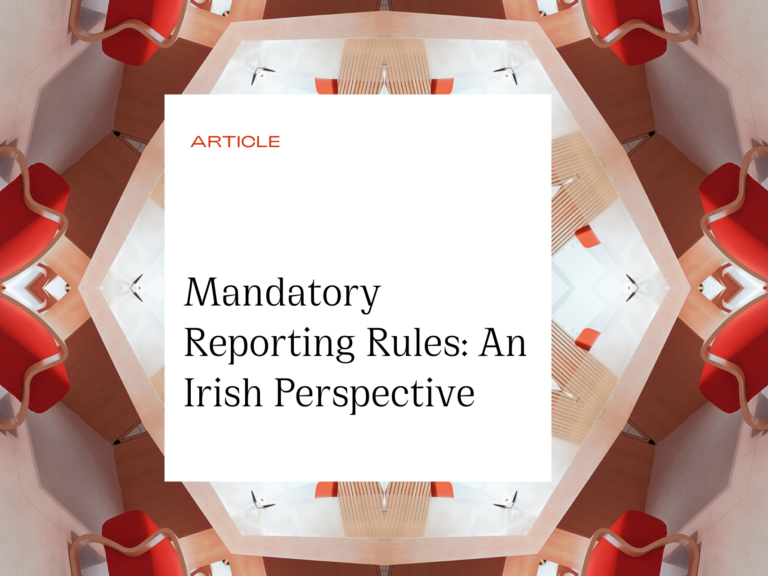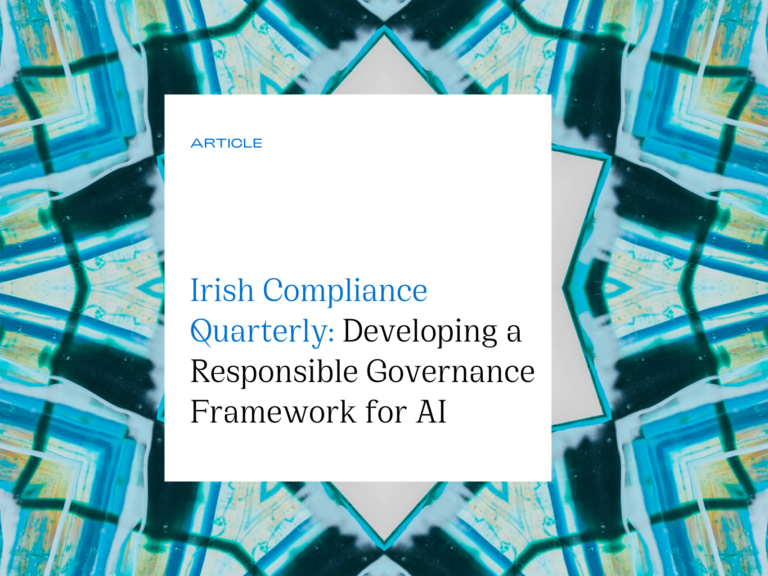
Sustainable Finance 2.0: Recent Developments in the Loan Market
Green loans and sustainability linked loans are becoming increasingly common in the loan markets. In this briefing, we analyse recently published guidance from the Loan Market Association (LMA), and highlight some notable market trends. Click here to view a pdf of the briefing.
Sustainable loans, such as green loans and sustainability linked loans, are becoming increasingly common in the loan markets (see our April 2019 briefing: Sustainable loans are here to stay).
Since Arthur Cox acted for Greencore Group plc on Ireland’s first sustainability linked revolving credit facility in January 2019, sustainability linked loans have significantly increased in popularity worldwide.
Recent green and sustainability linked loan transactions on which Arthur Cox has acted include Wells Fargo’s provision, in February 2020, of an upsized €300 million revolving credit facility to IPUT Real Estate Dublin, which included a €200 million green finance component in line with the LMA’s Green Loan Principles. Arthur Cox also acted as lenders’ Irish counsel on ESB’s February 2020 €1.4bn sustainability linked revolving facility agreement on which BNP Paribas acted as sustainability coordinator alongside a syndicate of thirteen other banks.
The LMA, together with the Loan Syndications and Trading Association and the Asia Pacific Loan Market Association, launched the Green Loan Principles in 2018 and the Sustainability Linked Loan Principles in 2019.
In May 2020, those three associations published:
- updated Green Loan Principles, together with new Guidance on the Green Loan Principles (the Green Loan Guidance); and
- updated Sustainability Linked Loan Principles, together with Guidance on the Sustainability Linked Loan Principles (the SLL Guidance).
Both new guidance documents seek to address frequently asked questions on the Green Loan Principles and the Sustainability Linked Loan Principles. This briefing analyses certain key observations in the Green Loan Guidance and the SLL Guidance, together with our observations on market developments.
| Reminder | |
|---|---|
| Green Loans | Green loans are any type of loan instrument made available exclusively to finance or re-finance, in whole or in part, new and/or existing eligible ‘Green Projects’. A non-exhaustive list of the types of projects that may be eligible to be treated as ‘Green Projects’ is set out in Appendix 1 to the Green Loan Principles. |
| Green Loan Principles | The Green Loan Principles set out the framework for understanding the characteristics of a green loan, based around four key components:
|
| Sustainability Linked Loans | Sustainability linked loans are any type of loan instruments and/or contingent facilities which incentivise the borrower’s achievement of ambitious, predetermined sustainability performance objectives. |
| Sustainability Linked Loan Principles | The Sustainability Linked Loan Principles set out a framework for understanding the characteristics of a sustainability linked loan, based around four key components:
|
Loan Pricing Mechanisms
The SLL Guidance reiterates that sustainability linked loans are loan instruments and/or contingent facilities which incentivise the achievement by the relevant borrower of ambitious, predetermined sustainability performance targets. This is the key factor which differentiates sustainability linked loans from green loans (which, per the Green Loan Principles, are applied towards financing or refinancing ‘Green Projects’).
In sustainability linked loans, pricing mechanisms linked to the borrower’s achievement of sustainability performance targets have generally been used to incentivise borrowers to achieve those targets. Recent market developments in this area have included:
Pricing ratchets
These pricing ratchets apply to commitment and/or utilisation fees and to interest margins. This reflects the fact that many sustainability linked loans are structured as revolving credit facilities for investment grade corporate borrowers which the parties often expect to remain undrawn for much of their tenor.
Variations on “two-way” margin/fee adjustments
Underperformance against the relevant sustainability performance targets will result in a borrower being required to:
- deposit an amount equal to the higher margin/fee into an account which can only be used for environmental, social or governance (ESG) purposes; or
- donate to a charitable organisation with an ESG objective.
This is intended to ensure that lenders do not benefit financially from borrowers’ underperformance against sustainability performance targets.
Avoiding Greenwashing
The term ‘greenwashing’ is used to describe a scenario in which a borrower or a project is held out to have green credentials, but those claims are misleading, inaccurate or inflated.
Sustainability Linked Loans – Targets
The SLL Guidance notes that:
- sustainability performance targets included in sustainability linked loans should be ambitious and meaningful; and
- performance against those targets must be adequately monitored and properly disclosed.
There are recent examples of sustainability linked loans using a range of bespoke sustainability performance targets, including targets in relation to:
- the use of recycled materials in retail products;
- the energy efficiency of office buildings;
- the gender diversity of workforces; and
- the carbon intensity of production processes.
This freedom for borrowers to select different sustainability performance targets reflects the fact that borrowers from many different industry sectors have entered into sustainability linked loans. However, the SLL Guidance recommends that:
- borrowers and lenders seek an external review as to the appropriateness of the sustainability performance targets agreed upon by them; and
- market participants should conduct materiality assessments to determine the core ESG considerations for the relevant borrower and its stakeholders by reference to its industry sector and operations.
The SLL Guidance also notes that sustainability performance targets should not be set at a less ambitious level than targets already adopted or publicly announced by the relevant borrower. To achieve a pricing reduction under its sustainability linked loan, a borrower should be required to show that it has outperformed the applicable targets rather than simply continuing on its existing trajectory. For example, the Finnish forestry company UPM signed a €750m sustainability linked loan in March 2020 under which one of the sustainability performance targets required a 65% reduction in its fuel and electricity emissions over a fifteen year period.
Sustainability Linked Loans – Reporting
As noted in the SLL Guidance, there are now widely adopted global standards for sustainability reporting such as the Global Reporting Initiative’s Sustainability Reporting Standards.
In the same way that lenders normally require borrowers to deliver financial reports in accordance with consistently applied generally accepted accounting principles, it appears increasingly likely that an equivalent approach will be expected in relation to ESG reporting in connection with sustainability linked loans and green loans.
The SLL Guidance notes that where a borrower plans to rely on its internal expertise for the purpose of calculating and reporting its performance against sustainability performance targets (rather than an external review), it will be necessary to consider factors such as:
- whether it has a dedicated internal ESG team;
- the scope of internal or external audit processes; and
- whether it is required to report data on its sustainability performance targets to its regulator in the ordinary course of business (and whether it is subject to financial penalties if it misreports to that regulator).
This highlights the fact that differing approaches to reporting sustainability performance targets may be appropriate in relation to, for example:
- a regulated utilities operator (which is likely to have significant experience in reporting on a range of relevant performance measures to a government or semi-state regulator); and
- a real estate investment trust (which may be at an earlier stage of developing its internal capabilities as to sustainability management).
Green Loans
It is important to note that certain loan products which are labelled as ‘green’ when provided may not qualify as ‘Green Loans’ for the purposes of the Green Loan Principles or the methodology used by league table providers such as Bloomberg and Refinitiv.
For example, commercial banks in various jurisdictions offer ‘green mortgages’ to retail customers to finance the acquisition of homes, or to SME customers to finance the acquisition of commercial premises, in each case with certain building energy ratings. Alternatively, those mortgages may be offered to finance the cost of refurbishing such properties to achieve those building energy ratings. However, these are unlikely to satisfy the requirements of the Green Loan Principles as to use of proceeds, process for project evaluation and selection, management of proceeds and reporting.
Short-Term Shocks to Long-Term Objectives
The COVID-19 pandemic has resulted in a flood of investment grade loan issuance as corporate borrowers seek to access liquidity in uncertain trading conditions. The need for quick execution has meant that borrowers have focussed on more conventional loan products rather than sustainability linked loans or green loans. Data from Refinitiv shows that around US$13bn of sustainability linked loans were issued in Q2 2020 compared with US$59bn in Q4 2019. However, as market conditions stabilise, it appears likely that the issuance of sustainability linked loans and green loans will resume its upward trajectory, particularly as more corporate borrowers convert their core revolving credit facilities into sustainability linked loans.
There has been recent speculation as to how the closures and other public health measures taken in response to the COVID-19 pandemic will affect borrowers’ performance against the sustainability performance targets included in their sustainability linked loans. To take an extreme hypothetical example, if an airline has set its sustainability performance targets by reference to targeted reductions in CO2 emissions, it may find it much easier than expected to achieve pricing reductions in circumstances where it is unable to operate its normal flight schedule for several months (although this is likely to be only a marginal benefit).
Some market participants did, however, anticipate this type of issue arising prior to the COVID-19 pandemic. At least one sustainability linked loan in excess of €1bn was issued in 2019 which included scope for sustainability performance targets to be recalibrated following the occurrence of a significant event which affected those targets or the wider ESG environment by more than an agreed margin.
The SLL Guidance also notes that sustainability performance targets may cease to be relevant, or require amendment, over the tenor of a sustainability linked loan, either as a result of changes to the wider ESG environment or as a result of disposals or acquisitions affecting the borrower’s core business. For example, if an energy company disposes of its core fossil fuels business and refocuses on renewables, its existing sustainability performance targets may no longer be fit for purpose. Borrowers and lenders should consider building mechanisms into the terms of their sustainability linked loans and/or green loans to address this scenario and avoid lengthy amendment and waiver processes at a later date.
ECB Guidance on Climate-Related and Environmental Risks
The European Central Bank (ECB) published a consultation on 20 May 2020 on a draft Guide on climate-related and environmental risks. The draft guide explains how the ECB expects banks to:
- consider climate-related and environmental risks in their governance and risk management frameworks and when formulating and implementing their business strategy; and
- become more transparent by enhancing their climate-related and environmental disclosures.
By the end of 2020, the ECB will expect banks classified as ‘significant’ for the purposes of the Single Supervisory Mechanism to inform the ECB of any divergences in their practices from the supervisory expectations set out in the draft guide.
Certain supervisory expectations set out in the draft guide relate directly to sustainability linked loans and green loans. For example, the draft guide states that loan pricing should reflect the following:
- Credit risk appetite and business strategy towards climate-related and environmental risks
Banks may consider incentivising their clients to properly consider these risks so as to improve their creditworthiness and resilience in relation to such risks. By way of example, interest rates could be linked to borrowers’ achievement of sustainability targets.
- The different costs driven by climate-related and environmental risks
Banks are expected to include a higher credit cost charge or differentiated funding costs for assets that are particularly affected by physical and transition risks arising from climate change.
Separately, in its Consultation on the Renewed Sustainable Finance Strategy (which closes in July 2020), the European Commission (the Commission) sought industry views on whether EU standards for sustainability linked loans and green loans should be developed. The Commission is concerned that it is becoming more difficult for customers to compare the increasing number of green, sustainability linked, ESG-related and other products.
The Central Bank of Ireland, in its recently published Annual Report 2019 and Annual Performance Statement 2019-2020, confirmed that it would be increasing the level to which it incorporates climate risk issues into its supervisory work, and its financial stability assessments.
This focus by the ECB, the Commission and the Central Bank of Ireland (and other EU and national competent authorities) on these areas will encourage further focus on green loans and sustainability linked loans. The requirements to identify borrowers’ material ESG risks and to deliver regular reporting in relation to the sustainability performance targets selected in sustainability linked loans is also likely to help financial institutions comply with their own disclosure obligations regarding their exposure to climate-related, environmental and other risks in their loan portfolios.



